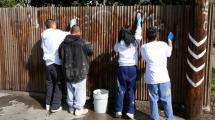Youth who receive special education services under the Individuals with Disabilities Education Act (IDEA 2004) and especially young adults of transition age, should be involved in planning for life after high school as early as possible and no later than age 16. Transition services should stem from the individual youth’s needs and strengths, ensuring that planning takes into account his or her interests, preferences, and desires for the future.
Risk and Protective Factors
What are Risk and Protective Factors?
- Risk factors are "personal traits, characteristics of the environment, or conditions in the family, school, or community that are linked to youth's likelihood of engaging in delinquency and other problem behaviors.” 1
- Protective factors are "those characteristics of the child, family, and wider environment that reduce the likelihood of adversity leading to negative child outcomes and behaviors, such as delinquency and later adult offending .2
In the context of youth involved or at risk of involvement with the juvenile justice system, risk factors can be considered to be those conditions or variables associated with a higher likelihood of delinquency and/or juvenile justice system contact; protective factors are those conditions which lessen this likelihood.3
Types of Protective and Risk Factors
Risk and protective factors for child delinquency have been identified 4 across multiple domains:
- Individual
- Family
- Peers
- School, neighborhood, and community
Table 1: Examples of risk and protective factors by domain
|
Risk Factors |
Domain |
Protective Factors |
|
● Early antisocial behavior and emotional factors such as low behavioral inhibitions ● Poor cognitive development ● Hyperactivity |
Individual |
● High IQ ● Positive social skills ● Willingness to please adults ● Religious and club affiliations |
|
● Inadequate or inappropriate child rearing practices, ● Home discord ● Maltreatment and abuse ● Large family size ● Parental antisocial history ● Poverty ● Exposure to repeated family violence ● Divorce ● Parental psychopathology ● Teenage parenthood ● A high level of parent-child conflict ● A low level of positive parental involvement |
Family |
● Participation in shared activities between youth and family (including siblings and parents) ● Providing the forum to discuss problems and issues with parents ● Availability of economic and other resources to expose youth to multiple experiences ● The presence of a positive adult (ally) in the family to mentor and be supportive |
|
● Spending time with peers who engage in delinquent or risky behavior ● Gang involvement ● Less exposure to positive social opportunities because of bullying and rejection |
Peer |
● Positive and healthy friends to associate with ● Engagement in healthy and safe activities with peers during leisure time (e.g., clubs, sports, other recreation) |
|
● Poor academic performance ● Enrollment in schools that are unsafe and fail to address the academic and social and emotional needs of children and youth ● Low commitment to school ● Low educational aspirations ● Poor motivation ● Living in an impoverished neighborhood ● Social disorganization in the community in which the youth lives ● High crime neighborhoods |
School/Community |
● Enrollment in schools that address not only the academic needs of youth but also their social and emotional needs and learning ● Schools that provide a safe environment ● A community and neighborhood that promote and foster healthy activities for youth ● Access to and participation in consistent mentoring |
It is important to note the following:
- No single risk factor leads a young person to delinquency.
- Risk factors do not operate in isolation and no single factor is responsible for explaining why an individual may experience negative outcomes like delinquency. "Violence results from a complex interplay of a variety of factors and requires nuanced, developmentally based responses tailored to the specific situation of each child.” 5
- When the risk factors a youth is exposed to cross multiple domains, the likelihood of delinquency increases at an even greater rate. 6
- Different risk factors may also be more likely to influence youth at different points in their development. For example, peer risk factors typically occur later in a youth’s development than individual and family factors.
- Because risk and protective factors are dynamic in nature, service providers and agencies should adopt ongoing assessments of these conditions. A thorough trauma-informed awareness of a person or group’s specific risk factors at the individual, familial, peer, and school/community levels will provide the most successful prevention and response intervention.
While youth may face a number of risk factors it is important to remember that everyone has strengths and is capable of being resilient: “All children and families have individual strengths that can be identified, built on, and employed” to prevent future delinquency and justice system involvement.7 In recent years, studies of juvenile delinquency and justice system involvement have increasingly examined the impact of these strengths (protective factors) on youth’s ability to overcome challenges and thrive.8
Resources
Child Abuse and Neglect Resources
This website shares resources, publications, and data sources on child abuse and neglect, including federal and non-federal resources for the public, interested community members, and practitioners.
Fact Sheet Template: Complex Trauma in Juvenile Justice-Involved Youth (PDF, 7 pages)
This fact sheet provides a detailed description of the path from complex trauma exposure to involvement in the juvenile justice system. The source also provides recommendations for judges and juvenile justice program administrators, parents and family members, and adults who supervise youth regarding how to best serve and understand justice-involved youth.
Child Abuse Training for Judicial and Court Personnel
This project trains judicial, legal, and social service professionals to improve their response in child abuse and neglect cases. It also teaches practitioners how to coordinate information and services across the juvenile justice and child welfare systems.
In Focus: Children's Advocacy Centers (PDF, 1 page)
This brief details the work of children's advocacy centers and their multidisciplinary teams of child abuse prevention and intervention professionals.
Victims of Child Abuse Act Program
This program works to improve the lives of those affected by maximizing the impact of victim services and ensuring professionals have access to effective and innovative training. OJJDP supports these initiatives under the program:
- Children's Advocacy Centers (CACs)
- Alaska and Tribal Children's Advocacy Centers Expansion
- Court Appointed Special Advocates/Guardian ad Litem (CASA/GAL)
- Child Abuse Training for Judicial and Court Personnel
Model Programs Guide: Arts-Based Programs and Therapies
This guide presents evidence-based juvenile justice and youth prevention, intervention, and reentry programs. Each program is rated either effective, promising, or no effect. Users can search the database for programs and interventions based on the age range of the child or young adult or use other search filters to find arts-based programs and therapies.
Model Programs Guide: Community-Based
This guide presents evidence-based juvenile justice and youth prevention, intervention, and reentry programs. Each program is rated either effective, promising, or no effect. Users can search programs and interventions based on the age range of the child or young adult or can use other search filters to find community-based prevention programming.
Model Programs Guide: Mentoring
This guide presents evidence-based juvenile justice and youth prevention, intervention, and reentry programs. Each program is rated either effective, promising, or no effect. Users can search the database for programs and interventions based on the age range of the child or young adult or can use other search filters to find mentoring programs.
Model Programs Guide: Parents and Families
This guide presents evidence-based juvenile justice and youth prevention, intervention, and reentry programs. Each program is rated either effective, promising, or no effect. Users can search the database for programs and interventions based on the age range of the child or young adult or can use other search filters to find parent and family-oriented programs.
Preventing Child Abuse & Neglect
This webpage features a list of resources related to child abuse prevention, protecting children from risk of abuse, and strengthening families.
Protective Factors Against Delinquency (PDF, 14 pages)
This literature review analyzes protective factors, or characteristics or conditions that may reduce the influence of risk factors causing delinquent and violent behavior, as a buffer against juvenile delinquency. Protective factors at the level of the individual, family, peer, school, and community are explored.
Tool Kit for Creating Your Own Truancy Reduction Program (PDF, 229 pages)
This toolkit provides a comprehensive analysis of the causes of truancy, the extent of the issue, evaluation measures for truancy reduction programs and barriers to accurate progress measurement, as well as best practices for managing truancy reduction among youth.
T. E. A. M., Teach, Empower, Affirm, Mentor, A Risk Reduction Mentoring Curriculum, Instructor’s Manual (PDF, 253 pages)
This curriculum manual is intended for implementation with middle school students and its aim is to address four central risk factors for delinquent behavior among this population. The curriculum takes a strengths-based approach that focuses on empowering youth and includes lessons on school engagement, peer relationships, and victimization.
References
1 Murray & Farrington, 2010
2 Vanderbilt-Adriance & Shaw, 2008; Developmental Services Group, Inc., 2013
3 Jessor, 1998
4 A study group comprised of nearly 40 experts convened by the U. S. Department of Justice Office of Juvenile Justice and Delinquency Prevention (OJJDP) identified four domains for risk and protective factors.
5 Office of Juvenile Justice and Delinquency Prevention & Centers for Disease Control and Prevention, 2016
6 Wasserman et al., 2003
7 Osher,1996, p. 186
8 Kendziora & Osher, 2004
Other Resources on this Topic
Agencies
Announcements
Collaboration Profiles
Conferences
Data Sources
Feature Articles
Programs
Publications
Resources
Technical Assistance
Tools & Guides
Training Resources
Videos & Podcasts
Webinars & Presentations
Websites
Youth Topics
Youth Briefs
Research links early leadership with increased self-efficacy and suggests that leadership can help youth to develop decision making and interpersonal skills that support successes in the workforce and adulthood. In addition, young leaders tend to be more involved in their communities, and have lower dropout rates than their peers. Youth leaders also show considerable benefits for their communities, providing valuable insight into the needs and interests of young people
Statistics reflecting the number of youth suffering from mental health, substance abuse, and co-occurring disorders highlight the necessity for schools, families, support staff, and communities to work together to develop targeted, coordinated, and comprehensive transition plans for young people with a history of mental health needs and/or substance abuse.
Nearly 30,000 youth aged out of foster care in Fiscal Year 2009, which represents nine percent of the young people involved in the foster care system that year. This transition can be challenging for youth, especially youth who have grown up in the child welfare system.
Research has demonstrated that as many as one in five children/youth have a diagnosable mental health disorder. Read about how coordination between public service agencies can improve treatment for these youth.
Civic engagement has the potential to empower young adults, increase their self-determination, and give them the skills and self-confidence they need to enter the workforce. Read about one youth’s experience in AmeriCorps National Civilian Community Corps (NCCC).






